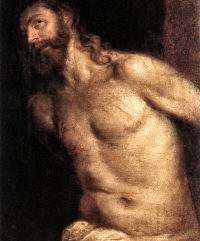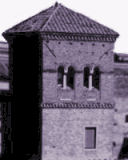
Daily Readings for:April 14, 2014
(Readings on USCCB website)
Collect: Grant, we pray, almighty God, that, though in our weakness we fail, we may be revived through the Passion of your Only Begotten Son. Who lives and reigns with you in the unity of the Holy Spirit, one God, for ever and ever.
RECIPES
ACTIVITIES
o Holy Week in the Catholic Tradition
o Housecleaning for Holy Week I
o Housecleaning for Holy Week II
o Lent Hymn: Open, O Hard and Sinful Heart!
o Monday, Tuesday and Wednesday of Holy Week in the Home
o Music for Lent and Easter: St. Matthew Passion by Bach
o The Passover Meal: 1. Introduction
PRAYERS
o Prayer for Monday of Holy Week
o Prayer for Palm Sunday and Holy Week
o Family Evening Prayer for Holy Week
· Lent: April 14th
· Monday of Holy Week
Old Calendar: Monday of Holy Week
"Here is my servant whom I uphold, my chosen one in whom my soul delights. I have endowed him with my spirit that he may bring true justice to the nations. He does not cry out or shout aloud, or make his voice heard in the streets. He does not break the crushed reed, nor quench the wavering flame (Is 42:1-2)."
Meditation - Mary and Judas
Today the liturgy presents two noteworthy characters who play dissimilar roles in the Lord's passion. One fills us with solace and comfort; the other with uneasiness and wholesome fear. Their juxtaposition produces a powerful effect by way of contrast. The two characters are Mary of Bethany and Judas.
Jesus is in the house of Lazarus, at dinner. Mary approaches, anoints the feet of her Savior for His burial and dries them with her hair. Judas resents her action and resolves upon his evil course. These two persons typify man's relation to Christ. He gives His Body to two types of individuals: to Magdalenes to be anointed, to Judases to be kissed; to good persons who repay Him with love and service, to foes who crucify Him. How movingly this is expressed in the Lesson: "I gave My body to those who beat Me, and My cheeks to those who plucked them. I did not turn away My face from those who cursed and spit upon Me."
The same must hold true of His mystical Body. Down through the ages Christ is enduring an endless round of suffering, giving His body to other Marys for anointing and to other Judases to be kissed, beaten, and mistreated. Augustine explains how we can anoint Christ's body:
Anoint Jesus' feet by a life pleasing to God. Follow in His footsteps; if you have an abundance, give it to the poor. In this way you can wipe the feet of the Lord.
The poor are, as it were, the feet of the mystical Christ. By aiding them we can comfort our Lord in His mystical life, where He receives Judas' kisses on all sides-the sins of Christians.
The Gospel account may be understood in a very personal way. In everyone's heart, in my own too, there dwell two souls: a Judas-soul and a Mary-soul. The former is the cause of Jesus' suffering, it is always ready to apostatize, always ready to give the traitor's kiss. Are you full master over this Judas-soul within you? Your Magdalen-soul is a source of comfort to Christ in His sufferings. May the holy season of Lent, which with God's help we are about to bring to a successful conclusion, bring victory over the Judas-soul and strengthen the Magdalen-soul within our breasts.
Excerpted from The Church's Year of Grace, Pius Parsch

The Station today is at the church of St. Praxedes which was built over St. Praxedes' house. It was one of the twenty-five original parishes in Rome. It is easily one of the most beautiful churches in the Eternal City and is bedecked with incredibly beautiful mosaics. The present church is the one built by Pope Adrian I c. 780, completed and altered by Pope St. Paschal I c. 822. It was enlarged at that time mainly to serve as a repository for relics from the catacombs.